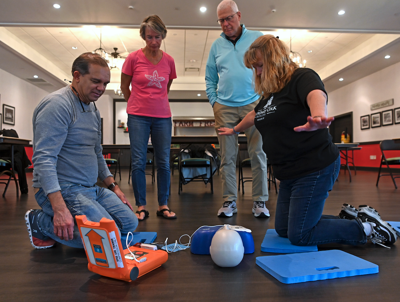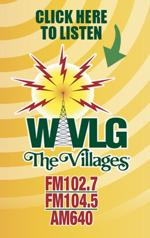Lifesaving practices pioneered in the world's largest retirement community are now unfolding across America, five years after The Villages Daily Sun published an in-depth report calling for the reforms.
All five solutions to reduce cardiac deaths — America's top killer — brought forward in the newspaper's 2019 investigation are now in place or in progress in communities across the country. They include:
Bringing lifesaving training to schools: The Daily Sun urged lawmakers nationwide to require all high school graduates to be trained in CPR and the use of automated external defibrillators (AEDs). In 2021, Florida responded with such a law, and today it is required in 43 states.
Organizing more citizen CPR/AED teams: The Daily Sun's database analysis chronicled how The Villages retirement community was home to more AEDs per capita than any community its size, contributing to a survival rate four times the national average. Five years later, The Villages has more than doubled its AED count to at least 1,290 and expanded its army of citizen responders from 4,000 to more than 6,000.
Embracing new technology: Sumter County has more than doubled in the past five years the number of users willing to be alerted to nearby victims. More than 4,000 resident responders are using the free phone app called PulsePoint that instantly connects CPR/AED trained people. "The work being done in the region is very impressive,” Richard Price, PulsePoint president, told the Daily Sun. Nationwide, the number of active users has now topped 1 million.
Making AED registration mandatory: The Daily Sun revealed how even in areas with hundreds of AEDs, people often don't know where to find them. While Florida still doesn't require AED owners to share their location, voluntary registration has increased.
Requiring cardiac arrest reporting: The Daily Sun strongly pressed for the sharing of data and best practices nationwide. That could save thousands of lives. Last year, the Centers for Disease Control and Prevention awarded $23 million to this effort, making a national registry possible within five years.
The actions are crucial at time that heart disease is more lethal than ever.
Today, it is responsible for one in every three deaths in America, up from one in every four just a decade ago.
About 2,600 Americans will succumb to a cardiac event today, or about 900,000 people this year, according to the CDC.
Florida leads the nation with about 25,000 out-of-hospital cardiac arrests each year, Dr. Keith Lurie told a room full of paramedics at the annual Florida Firefighters Conference in January.
With a national survival rate of less than 10%, that's the equivalent of losing the entire population of Clearwater Beach in five years.
Army of AED responders continues to expand
Because every second counts in a cardiac arrest, the chain of survival still begins with bystanders who know how to keep a heart going until professional help arrives.
In that regard, The Villages leads the state, said Thomas DiBernardo, Florida's coordinator of the budding national registry CARES (Cardiac Arrest Registry for Enhanced Survival).
In Sumter County, a bystander has already started CPR in 65% of the cases to which EMS professionals are called.
Most of those efforts come from the Neighbors Saving Neighbors program, the 2003 brainchild of Lew Simon, of the Village of Glenbrook, that today boasts 6,000 CPR trained residents armed with 864 AEDs.
Simon says he takes calls regularly helping the program spread locally as close as Clermont and nationally from Oregon to North Carolina.
"I've not seen a program that has as much as promise as this one,” said Dr. Kenneth Scheppke, Florida's former EMS medical director who now serves as the Florida Department of Health's deputy secretary for health.
In the high schools, Florida has now trained more than a half million graduates to assist.
Edward Kosiec of Boynton Beach recounted to legislators going into sudden cardiac arrest at a Chick-Fil-A restaurant at the same time the Daily Sun 2019 report was published. A high school senior working at the restaurant administered CPR, saving Kosiec's life.
"Now, we'll have an army of life savers, year after year, who know what to do,” he said.
He has now launched Every Second Counts CPR, to join Simon in training everyday citizens to perform CPR and be familiar with AEDs.
Kosiec spent last year's CPR and AED Awareness week on the National Mall in hopes of reaching a wider audience.
"I am here today because somebody cared,” he told weekend tourists stopping by. "Seventy to eighty percent of the time the victim is going to be a loved one in your own family. So please, I beg you to please learn CPR.”
More areas exploring lifesaving technologies
One year after the Daily Sun's report, researchers began exploring a new way to better the survival odds with a new approach to CPR.
"The reality is, we've hit a ceiling with that (traditional CPR) approach,” said Dr. Lurie, a Minnesota cardiologist who co-invented "neuroprotective CPR” after treating a patient whose family resorted to a toilet plunger to keep his heart going. "We have about 7% survival rate nationally, 12% in some areas."
Neuroprotective CPR allows professional responders to use a $20,000 backpack-sized kit that consists of a mechanical compression machine, an elevation device for the head and a regulated breathing tube.
It's plunger-like approach allows oxygen-starved blood in the brain to drain more effectively and be replenished more quickly with oxygenated blood.
"Florida has really been the hotbed for neuroprotective CPR” Dr. Lurie said.
In fact, nearly 90 EMS agencies in Florida, including The Villages Public Safety Department, are now approved to use the kits, and the early results show promise.
Former emergency medical technician Jason Benjamin, of St. Johns County, suffered his own cardiac arrest in 2021, and medics applied the new CPR in his "code” for 24 minutes. Benjamin was astonished, based on his own professional training, that he survived without brain damage after being down so long. It was Benjamin who convinced Dr. Lurie and others to name the process "neuroprotective CPR” after the way it protected his brain.
In Minnesota, medics in the city of Edina gained a pulse back on a cardiac arrest patients 60% of the time since using the new form of CPR, Dr. Lurie said.
And last year, Dallas County's emergency medical services director reported that among patients who received the new CPR method within 11 minutes of cardiac arrest, 6.1 percent survived with brain function intact, compared with just 0.6 percent who received traditional CPR.
Any day now, those same techniques will be available here, said The Villages Public Safety Department Division Chief of EMS Kenny Wannen.
"We felt in our community this would be a tremendous benefit where we have a great number of cardiac arrests,” Wannen said. "Every element of this system works for us. The protocols are in place, the devices are ready to order.”
Different approaches to find the closest AED
It's estimated that there are 4.5 million in AEDs in the United States, which accounts for about 66% of the global market.
The industry is trying to emerge from a manufacturing shortage, attributed to supply chain issues and the rise in popularity of the device following the high-profile cardiac arrest of Buffalo Bills player Damar Hamlin, who was resuscitated after collapsing during a 2022 nationally televised NFL game.
Except for a few niche groups, the state still does not require AED owners to register the devices. But private owners are encouraged to at least log the their AED devices with county EMS officials.
The ability to access AED locations varies widely across the state.
Some counties, like Sumter and Orange, direct AED registrations to PulsePoint, while others accept it through their websites.
Leon County has 1,375 AED devices listed in its computer aided dispatch system, according to spokeswoman Lauryl Hinson.
Pinellas County officials estimate they have about 1,080 registered AEDs.
Hillsborough County officials estimate there are 550 to 600 registered, but aren't sure if some are duplicates.
In Palm Beach County, Palm Beach Gardens Fire & Rescue won a PulsePoint contest by getting the most AEDs registered in a month — 179.
And St. Johns County near St. Augustine, collects AED information, but doesn't use it for 911 calls because there is no ability to verify if privately owned devices are maintained or have been moved, according to Greta Hall, the county's former AED program manager. Instead, she said, a 911 operator can direct a caller to one of the 23 AED cabinets in public parks.
Outside The Villages locally, Sumter County Fire Rescue Chief Rob Hanson said last month that a new countywide public AED program has installed 34 devices and will target RV parks as well as county and city parks in the future. The PulsePoint app will alert any CPR-trained person within a half-mile radius of a cardiac arrest call.
Meanwhile, Tampa General Hospital is partnering with Manatee County and a third-party vendor to use drones to deliver AEDs to eligible 911 callers in Manatee County starting May 1, the hospital announced. While an AED delivery by drone program was launched in 2019 in Nevada, Tampa General Hospital will be the first-in-the-nation to transport three pieces of life-saving equipment.
Advocacy groups break walls to sharing success
Journalists and EMS officials have pressed CARES for years to make public its cardiac arrest data gathered for 33 states and 51 communities in another 14 states since its creation 20 years ago.
The $24 million CDC award will allow CARES to collect data from all 50 states, including which interventions resulted in the best outcomes.
"This expansion will facilitate a deeper understanding of disparities that exist in various communities, enabling locally tailored interventions to bridge the gaps,” said CARES Executive Director Bryan McNally.
Still, data produced by the registry is not widely available, with CARES citing patient privacy laws in withholding even success and failure rates across communities from the media.
"Often times, I have found it as a very convenient excuse,” said David Hiltz, chief innovation officer for the Citizen CPR Foundation, a group that advocates training lay responders and is frustrated by CARES and other agencies which withhold data. "It will not violate the privacy act if (the findings) are in research, but they will not share the data.”
Another advocacy group is taking the effort directly to EMS officials.
King County, Washington is widely considered the best place to survive a cardiac arrest, where survival rates for witnessed, shockable cardiac arrests was 48% in 2023, according to the county.
It's home to Seattle's Medic One, the highly regarded paramedic programs that credits bystanders for performing CPR in 71% of their cardiac calls.
Since 2008, they've shared the successes of different practices by creating the Global Resuscitation Academy, whose mission is "to create a world in which no one dies of cardiac arrest.”
The academy has produced more than 3,000 alumni in more than 700 communities. It is also member of the Global Resuscitation Alliance, convened in 2015 at the Utstein Abbey in Norway.
Hiltz said public education and training is one of the key community-based strategies.
He said there is no reason every community can't improve, not just certain ones.
"Improving cardiac arrest survival is a lot like baking a cake. Everyone has the same access to all the ingredients,” said Hiltz, of the Citizen CPR Foundation. "The riddle is — why doesn't everyone's cake rise? Because they're not willing to do the hard work and collaborate.”
Curt Hills is a senior managing editor with the Daily Sun. He can be reached at (352) 753-1119, ext. 5287 or curt.hills@thevillagesemedia.com.












Commented
Sorry, there are no recent results for popular commented articles.